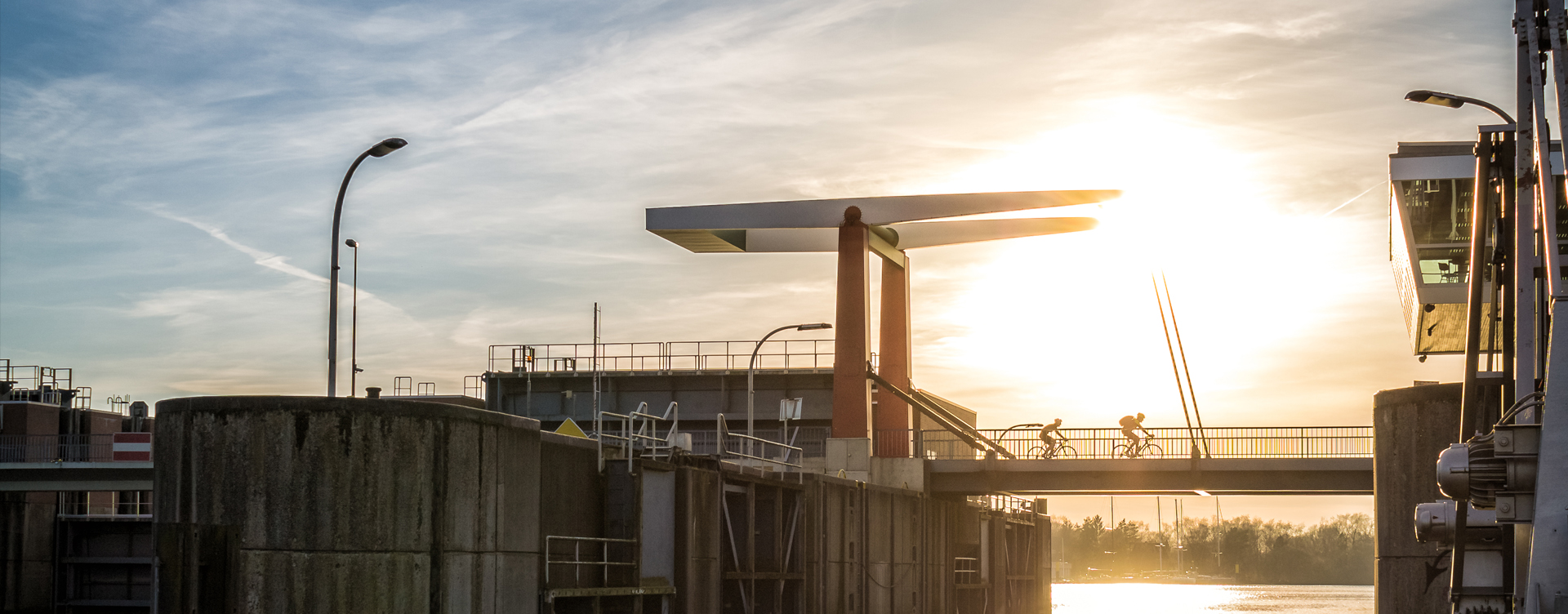Lesum
barrage
Most Bremen citizens use the Lesum barrage on a Sunday bicycle trip as a means to cross the river.
Its actual function for water management and its outstanding importance for Bremen ‘s flood protection is less considered.
The key event for building the barrage was, however, the February storm surge of 1962.
The storm surge during the night from the 16th to 17th February 1962 had proven the insufficiency of the storm surge protection in an alarming way.
Although the dikes of Lesum and Wümme had held up and floodings on the right side of the Weser only just stayed away, the dikes had overflowed in several places and were also considerably damaged.
The possibilities for creating an effective high-water protection were, on the one hand, to heighten considerably the length of the dike along Lesum, Wümme and Hamme, today lying behind the barrage, or, on the other, to build barrages to create relief. It showed that high water protection could best be maintained by building barrages.
In doing so, it was logical that not only one barrage, but three for Lower Weser tributaries Hunte, Octum and Lesum had to be built.
In November 1968, Bremen and Lower Saxony signed an administrative agreement for the implementation of these measures.
The barrages were put into operation on October 1st, 1979.
The Lesum barrage is operated in such a way that all floods that are, at the Vegesack water gauge, higher than 2.70 m above mean sea level will be turned.
This is the standard blocking manoeuvre carried out most often at the barrage.
Moreover, in the case of high waters in the upper reaches of the river Wümme , the barrage can prevent floodings of areas in the upper reaches by early closures and a blocking at 2.00m above mean sea level.
To avoid crop failures when there is very high water in the Wümme meadows, there can also closings be carried out at slack tide, i.e., the lowest level of water, to aid the fast run-off of the Wümme water.
These closurs are, however, only carried out in extreme situations.
The operation of the barrage requires the staff of the Deichverband (Dike association) to monitor and project the water levels at 365 days in the year, around the clock.
The prognosis whether the barrage has to be closed for safety reasons is projected according to the tides at other water gauges in the course of the Lower Weser and the North Sea Coast like the lighthouse Alte Weser and Fedderwardersiel.
If you look upriver, in the direction of the Hamme, it is plain to see that the Lesumbrok Dike has not the full height of the Weserdeich.
Here, the dike is lowered from 7 metres above mean sea level to 4.50 metres. In order that the lowered dike is, after strong inflow from the Wümme, still safe, the Lesum barrage has a high-performance pumping station with three pumps that each can bring 15m³ per second in front of the barrage.
This shall prevent the water gauge upstream of the barrage rising higher than 3.20 above mean sea level and thus endangering the safety of the dike.
The average of closures of the barrage amounted, in the first 20 years after putting it into operation, to ca. 109 closing incidents per year.
Through the recent dredgings of Outer and Lower Weser, more frequent closures occur.
In the next years, the barrage will be redesigned for a greater flood safety.
To this end, the now existing floodgates are going to be built higher.
Contact
Lesumsperrwerk
Am Wasser 41
28757 Bremen
phone.: 0421 – 62 67 950
mail: lesumsperrwerk@arcor.de

